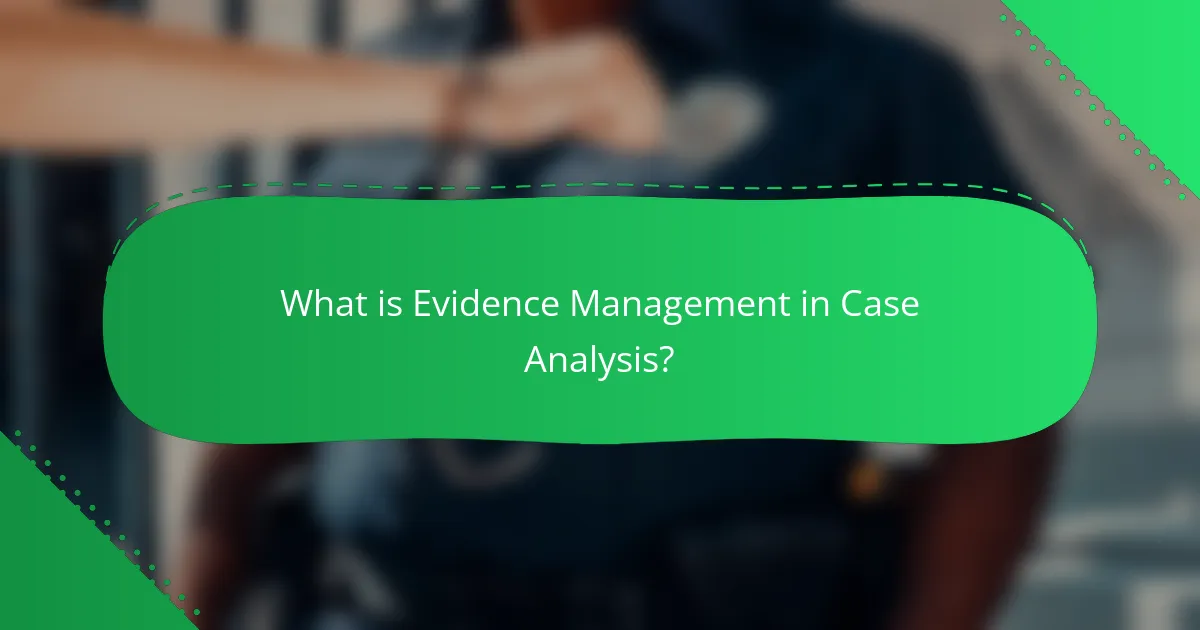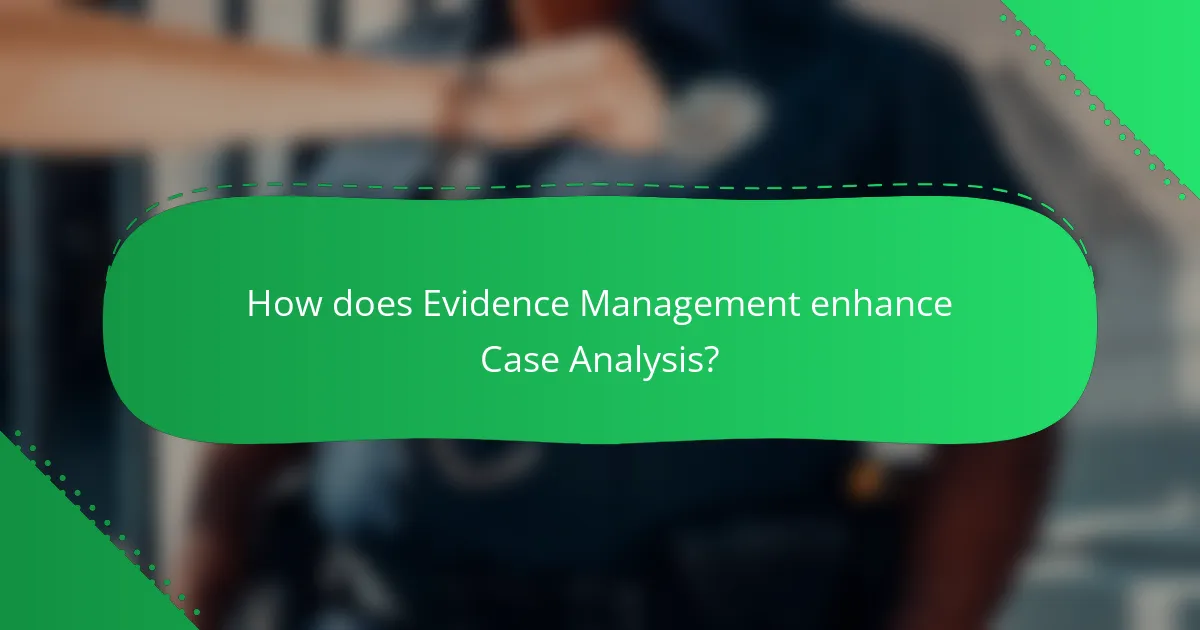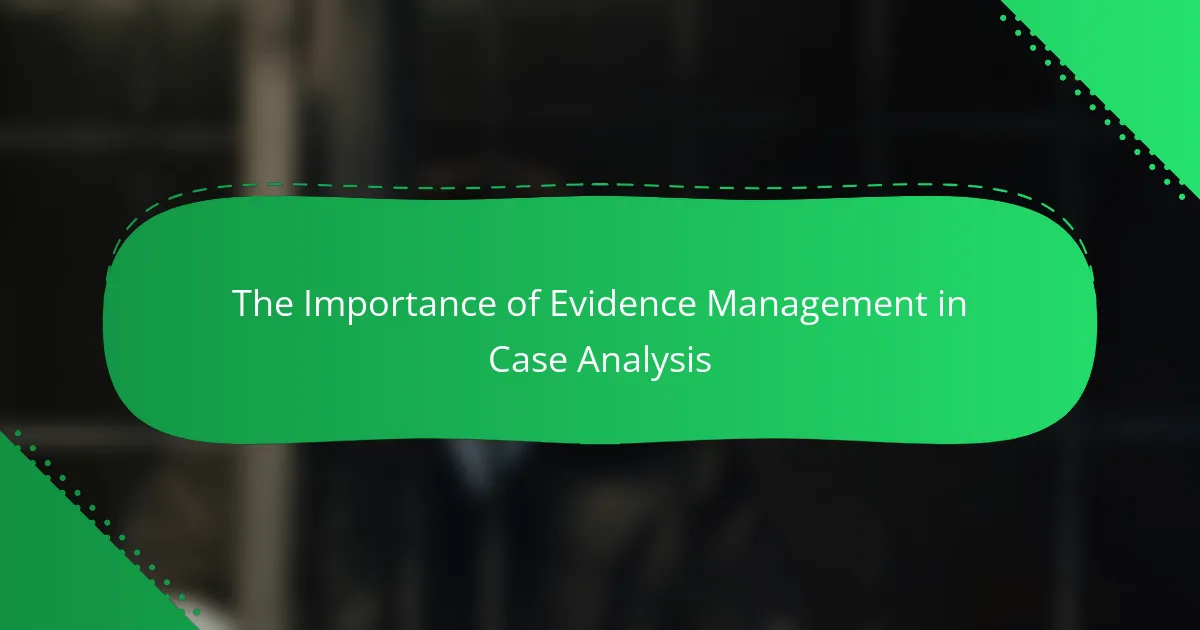Evidence management is the systematic process of collecting, preserving, and analyzing evidence relevant to legal cases, ensuring that it maintains integrity and admissibility in court. This article outlines the importance of effective evidence management in case analysis, highlighting key practices such as documentation, chain of custody, and proper storage methods that enhance credibility and reliability. It also addresses challenges faced in evidence management, including the preservation of evidence integrity, organization of data, and technological limitations. By emphasizing the need for improved practices and technologies, the article underscores the critical role of evidence management in supporting thorough and effective case analysis.

What is Evidence Management in Case Analysis?
Evidence management in case analysis refers to the systematic process of collecting, preserving, and analyzing evidence relevant to a legal case. This process ensures that all evidence is handled in a way that maintains its integrity and admissibility in court. Effective evidence management involves documentation, chain of custody, and proper storage methods. These practices are crucial for establishing facts and supporting arguments during legal proceedings. Research indicates that well-managed evidence can significantly impact case outcomes by enhancing credibility and reliability.
Why is Evidence Management critical in legal contexts?
Evidence management is critical in legal contexts because it ensures the integrity and reliability of evidence presented in court. Proper evidence management maintains a clear chain of custody. This chain prevents tampering or contamination of evidence. Accurate documentation of evidence helps establish its authenticity. Effective evidence management also facilitates thorough case analysis. It allows legal professionals to access and review evidence systematically. According to the National Institute of Justice, proper evidence handling can significantly impact case outcomes. Cases with well-managed evidence are more likely to result in just verdicts.
What are the key principles of effective evidence management?
The key principles of effective evidence management include proper collection, documentation, storage, and retrieval of evidence. Proper collection ensures that evidence is gathered in a way that maintains its integrity. Documentation involves recording details about the evidence, such as the time, place, and method of collection. Storage requires secure and organized environments to prevent contamination or loss. Retrieval processes must be efficient to ensure evidence can be accessed when needed. These principles help maintain the chain of custody and support the reliability of evidence in legal contexts. Effective evidence management is crucial for case analysis and decision-making.
How does evidence management impact case outcomes?
Effective evidence management significantly influences case outcomes. Properly organized and preserved evidence enhances the ability to build a compelling case. It ensures that relevant information is easily accessible during legal proceedings. Inaccurate or mishandled evidence can lead to wrongful convictions or dismissals. Research shows that cases with well-managed evidence have higher success rates. For instance, a study by the National Institute of Justice found that effective evidence handling improves case resolution times. This underscores the critical role of evidence management in achieving just outcomes.
What types of evidence are commonly managed in case analysis?
Types of evidence commonly managed in case analysis include physical evidence, documentary evidence, and testimonial evidence. Physical evidence consists of tangible items relevant to the case. This can include objects, weapons, or any materials that can be analyzed. Documentary evidence encompasses written or recorded information. Examples are contracts, emails, and reports that provide context or details about the case. Testimonial evidence involves statements made by witnesses or experts. These testimonies can provide insights or clarify facts surrounding the case. Each type of evidence plays a crucial role in building a comprehensive understanding of the situation at hand.
How do physical and digital evidence differ in management?
Physical evidence refers to tangible items that can be seen and touched, such as documents or objects. Digital evidence, on the other hand, consists of electronic data, including emails, files, and digital records. Management of physical evidence involves handling, storing, and preserving items in a physical location. This often requires secure storage facilities and proper chain-of-custody procedures.
In contrast, managing digital evidence involves ensuring data integrity, security, and accessibility through digital systems. This includes using software tools for data recovery and analysis. Additionally, physical evidence can degrade over time, necessitating careful preservation methods. Digital evidence can be duplicated easily, allowing for multiple copies without loss of quality.
The differences in management practices stem from the inherent characteristics of each type of evidence. For instance, physical evidence may require environmental controls, while digital evidence relies on cybersecurity measures. Understanding these distinctions is crucial for effective case analysis and evidence management.
What role does testimonial evidence play in case analysis?
Testimonial evidence plays a crucial role in case analysis by providing firsthand accounts that support claims. It enhances the credibility of the analysis through personal experiences and observations. Testimonial evidence can offer unique insights that quantitative data may not capture. It often serves to humanize the case, making it relatable and comprehensible. In legal contexts, testimonial evidence can be pivotal in influencing outcomes. It can sway opinions by presenting emotional and factual narratives. Research indicates that jurors often rely heavily on testimonials when making decisions. This reliance underscores the importance of managing and presenting testimonial evidence effectively.

How does Evidence Management enhance Case Analysis?
Evidence management enhances case analysis by ensuring organized, accessible, and verifiable information. Effective evidence management enables investigators to track evidence from collection to presentation. This process minimizes errors and promotes accuracy in analysis. Organized evidence allows for quicker retrieval, facilitating timely decision-making. Additionally, it supports collaboration among team members by providing a shared resource. Proper documentation within evidence management strengthens the credibility of findings. According to the National Institute of Justice, well-managed evidence significantly contributes to successful case outcomes. Thus, evidence management is crucial for thorough and effective case analysis.
What are the benefits of systematic evidence management?
Systematic evidence management enhances the reliability and validity of case analysis. It ensures that all relevant data is organized and easily accessible. This organization reduces the risk of overlooking critical information. It also facilitates better decision-making by providing a comprehensive view of evidence. Additionally, systematic management supports transparency and accountability in case handling. Studies show that structured evidence management can lead to improved outcomes in legal and investigative processes. For example, a report by the National Institute of Justice highlights that organized evidence leads to more effective case resolutions. Overall, systematic evidence management streamlines processes and strengthens case integrity.
How does organized evidence contribute to case clarity?
Organized evidence enhances case clarity by providing a structured framework for analysis. This structure allows for easier identification of key facts and relationships. When evidence is systematically categorized, it reduces ambiguity. Clear organization helps stakeholders understand the narrative and context of the case. It also facilitates quicker retrieval of relevant information during discussions. Studies have shown that cases with well-organized evidence lead to more accurate conclusions. In legal settings, organized evidence can significantly impact jury understanding and decision-making. Thus, effective evidence management is crucial for achieving clarity in case analysis.
What efficiencies are gained through effective evidence management?
Effective evidence management enhances organizational efficiency by streamlining processes and improving accessibility. It reduces the time spent on searching for documents and evidence, leading to quicker case resolutions. Efficient evidence management systems enable better tracking and organization of materials. This results in fewer errors and inconsistencies in case analysis. A study by the National Institute of Justice found that effective evidence management can reduce case processing times by up to 30%. Improved collaboration among teams is another efficiency gained, as centralized evidence allows for easier sharing and communication. Overall, effective evidence management leads to significant resource savings and better outcomes in case analysis.
How does technology influence evidence management practices?
Technology enhances evidence management practices by improving data collection, storage, and analysis. Digital tools enable efficient organization of evidence, ensuring easy retrieval. Cloud storage solutions provide secure access to evidence from multiple locations. Automated tracking systems reduce human error in evidence handling. Advanced analytics software allows for deeper insights into case data. Technologies like blockchain ensure the integrity and authenticity of evidence. Mobile applications facilitate real-time evidence documentation in the field. Overall, technology streamlines processes, increases accuracy, and strengthens the reliability of evidence management.
What tools are available for managing evidence in case analysis?
Tools available for managing evidence in case analysis include case management software, digital evidence management systems, and document management tools. Case management software like Clio or MyCase provides features for organizing case files and tracking evidence. Digital evidence management systems such as CaseGuard or Evidence.com allow for secure storage and retrieval of digital evidence. Document management tools like M-Files or SharePoint facilitate the organization and sharing of documents related to cases. These tools enhance efficiency and accuracy in handling evidence throughout the case analysis process.
How can software solutions improve evidence tracking?
Software solutions can significantly enhance evidence tracking by automating data collection and organization. These systems streamline the process of documenting evidence, ensuring accuracy and consistency. They provide centralized databases that allow for easy access and retrieval of evidence. Additionally, software solutions often include tracking features that log the chain of custody, which is critical for legal integrity. Many solutions also support integration with other case management tools, improving overall workflow efficiency. Research indicates that organizations using software for evidence management report a reduction in errors by up to 30%. This increase in reliability is essential for case analysis and decision-making.

What challenges exist in Evidence Management for Case Analysis?
Evidence management for case analysis faces several challenges. One major challenge is the preservation of evidence integrity. Maintaining the chain of custody is crucial to ensure that evidence remains admissible in court. Another challenge is the organization of vast amounts of data. Case files can contain numerous documents, images, and digital files, making it difficult to retrieve specific evidence quickly. Additionally, there is often a lack of standardized procedures across different jurisdictions, leading to inconsistencies in evidence handling.
Technological limitations also pose challenges. Not all organizations have access to advanced evidence management systems, which can hinder efficiency. Furthermore, training personnel on proper evidence management techniques is often inadequate. This can result in mishandling or loss of critical evidence. Lastly, legal and ethical considerations can complicate evidence management, especially regarding privacy concerns.
These challenges highlight the need for improved practices and technologies in evidence management to support effective case analysis.
What common pitfalls should be avoided in evidence management?
Common pitfalls in evidence management include inadequate documentation, which can lead to confusion about the evidence’s chain of custody. Failing to properly label and store evidence can result in contamination or loss. Neglecting to train staff on evidence handling protocols increases the risk of mishandling. Additionally, poor communication among team members can lead to duplicated efforts or overlooked evidence. Inconsistent evidence tracking methods can hinder case analysis and lead to errors. Ignoring the need for regular audits can allow discrepancies to go unnoticed. Finally, not utilizing technology effectively can result in inefficient evidence management processes.
How can mishandling evidence affect legal proceedings?
Mishandling evidence can severely impact legal proceedings. It can lead to the exclusion of crucial evidence in court. This exclusion may weaken the prosecution’s or defense’s case. As a result, the overall integrity of the legal process is compromised. Mishandled evidence can also result in wrongful convictions or acquittals. According to a study by the Innocence Project, improper evidence handling contributed to over 50% of wrongful convictions. Thus, maintaining proper evidence management is essential for a fair trial.
What are the consequences of poor evidence documentation?
Poor evidence documentation can lead to significant negative consequences. These consequences include compromised case integrity. Inaccurate or incomplete documentation can result in wrongful conclusions. It may also lead to legal challenges and increased liability. Poor documentation can hinder the ability to retrieve evidence when needed. This can cause delays in legal proceedings. Additionally, it can undermine the credibility of the involved parties. A study by the National Institute of Justice found that proper documentation increases case success rates.
How can best practices be implemented in evidence management?
Best practices in evidence management can be implemented through systematic procedures and technology integration. Establishing a clear chain of custody is essential to maintain evidence integrity. Utilizing digital evidence management systems enhances tracking and accessibility. Regular training for personnel ensures adherence to protocols. Conducting audits helps identify areas for improvement. Implementing standardized documentation practices reduces errors. Engaging stakeholders in policy development fosters a culture of accountability. These strategies collectively enhance the reliability and efficiency of evidence management.
What steps can professionals take to enhance evidence integrity?
Professionals can enhance evidence integrity by implementing strict chain-of-custody protocols. These protocols ensure that all evidence is tracked from collection to presentation. Proper documentation is essential during each stage of handling evidence. This includes recording who collected the evidence, when it was collected, and how it was stored. Regular training on evidence handling for all personnel is crucial. This training should cover legal standards and best practices. Utilizing tamper-evident packaging can also help maintain the integrity of evidence. Additionally, employing digital tools for evidence management can reduce human error. Research shows that adherence to these practices significantly reduces the risk of evidence contamination and mishandling.
How can training improve evidence management skills?
Training can significantly improve evidence management skills by providing structured learning and practical experience. It equips individuals with essential techniques for organizing and preserving evidence. Training enhances understanding of legal standards and procedures related to evidence handling. Participants learn to utilize technology effectively for evidence tracking and documentation. Skill development through training leads to increased accuracy in evidence collection and analysis. Studies show that trained professionals demonstrate higher competency in managing case-related evidence. For example, a report by the National Institute of Justice highlights that training programs improve evidence integrity and case outcomes.
What are the future trends in Evidence Management for Case Analysis?
Future trends in evidence management for case analysis include increased automation and integration of artificial intelligence. AI technologies will enhance data processing, allowing for quicker analysis and decision-making. Cloud-based solutions will facilitate real-time collaboration among legal teams. Blockchain technology will ensure the integrity and traceability of evidence. Additionally, data analytics will provide deeper insights into case patterns and outcomes. These advancements aim to improve efficiency and accuracy in legal proceedings. The shift towards digital evidence management systems is already underway, with a growing number of firms adopting these technologies. As a result, evidence management will become more streamlined and effective in supporting case analysis.
How is artificial intelligence shaping evidence management?
Artificial intelligence is transforming evidence management by enhancing data processing and analysis. AI algorithms can quickly sort through large volumes of evidence. This capability reduces the time needed for manual review. Machine learning models can identify patterns and anomalies in the data. These insights help in determining the relevance of evidence. AI also improves accuracy by minimizing human error in data handling. Additionally, predictive analytics can forecast case outcomes based on historical evidence. These advancements lead to more efficient case analysis and better decision-making.
What emerging technologies should professionals be aware of?
Professionals should be aware of artificial intelligence, blockchain, and quantum computing. Artificial intelligence enhances data analysis and decision-making. It automates repetitive tasks, improving efficiency. Blockchain provides secure, transparent record-keeping. It is increasingly used in contract management and supply chain tracking. Quantum computing offers unprecedented processing power. It can solve complex problems beyond current capabilities. These technologies are transforming industries and driving innovation. Staying informed about them is crucial for professionals.
What practical tips can improve evidence management in case analysis?
Organizing evidence systematically enhances evidence management in case analysis. Use a centralized digital platform to store all evidence. This improves accessibility and reduces the risk of loss. Implement a standardized naming convention for files. This practice aids in quick identification and retrieval of documents. Regularly update and review evidence to ensure its relevance. This helps maintain the integrity of the case analysis. Train team members on best practices for evidence handling. Proper training minimizes errors and ensures consistency. Utilize checklists to track evidence collection and analysis steps. Checklists help maintain thoroughness and prevent oversight.
The main entity of the article is evidence management in case analysis. The article provides a comprehensive overview of the systematic process of collecting, preserving, and analyzing evidence relevant to legal cases, emphasizing its critical role in maintaining evidence integrity and admissibility in court. Key principles of effective evidence management, including proper collection, documentation, and storage, are outlined, along with the impact of well-managed evidence on case outcomes. It also discusses the types of evidence commonly managed, challenges faced in evidence management, and the influence of technology on practices. Overall, the article highlights the importance of systematic evidence management for achieving just and accurate legal resolutions.



